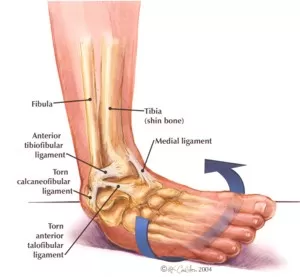An ankle sprain refers to the tearing of the ligaments of the ankle. The most common ankle sprain occurs on the lateral or outside part of the ankle. This is an extremely common injury that affects many people during a wide variety of activities. It can happen in the setting of an ankle fracture (i.e. when the bones of the ankle also break). Most commonly, however, it occurs in isolation.

Causes of ankle sprain
Any movement that suddenly twists the foot beyond the natural range of motion can cause an ankle sprain such as:
- Landing wrong when jumping or running on to an uneven surface.
- Stepping off a curb wrong
- Slipping on ice
- Tripping on a hole in the ground
Consequences of ankle sprain
When an ankle is sprained, the ankle bone itself is uninjured. It is the ligaments surrounding the ankle bone that suffer. Ligaments are structures in every joint in the body that help control the joint’s movement. The ligament will become injured if it is stretched too far which could result in a partial or complete tear. There are two different types of ankle sprain.
- The inversion ankle sprain is the most common type of sprain and occurs when the foot falls inward and stretches the outer ligaments too far. Pain occurs on the outside of the ankle and not on the inside of the ankle.
- The eversion ankle sprain occurs when the foot is twisted outwards and the inner ligament is stretched too far. Pain will occur on the inside, and not the outside, of the ankle.
The Severity of an Ankle Sprain
First-degree symptoms – a first-degree ankle sprain is when the ligaments have been stretched but not torn. Symptoms include:
- Mild pain
- Some swelling
- Some joint instability
- Mild joint stiffness
- Difficulty jogging or jumping
Second-degree symptoms – a second-degree ankle sprain is the most common of ankle injuries and is a partial tearing of the ligament. Symptoms include:
- Significant swelling
- Bruising
- Moderate pain
- Some loss of motion or use of the ankle
- Trouble walking
Third-degree symptoms -– a third-degree ankle sprain is the most severe of ankle injuries. With this sprain, the ligament has been torn completely. Symptoms include:
- Severe swelling
- Severe pain
- Instability of the joint
- Extreme loss of motion
- Walking can be quite painful
Treatment for Ankle Sprains
Rest – especially in the first 24 to 48 hours
Ice – for the first 48 hours for 20 minutes at a time
Compression – wear a
brace or a wrap that is snug, but not cutting off circulation
Elevate – above the heart as often as possible
Physical therapy is a mainstay. Patients should learn to strengthen the muscles around the ankle, particularly the peroneals. An ankle brace can be used in an athlete until a therapist believes that the ankle is strong enough to return to play without it. Surgery is rarely indicated but may be needed in a patient who has cartilage damage or other related injuries. Ligaments are only repaired or strengthened in cases of chronic instability in which the ligaments have healed but not in a strong fashion.
Frequently Asked Questions
What is a high ankle sprain and is that different from a regular ankle sprain?
A
high ankle sprain refers to tearing of the ligaments that connect the tibia to the fibula (this connection is also called the syndesmosis). These are different and much less common than the standard lateral ankle sprains, meaning those that occur on the side of the ankle.
Do ankle sprains ever need to be repaired acutely?
Ankle sprains rarely, if ever, needed to be treated with surgery. The vast majority simply need to be treated with rest, ice, compression and elevation followed by physical therapy and temporary bracing.
I have sprained my ankle many times. Should I be concerned?
Yes. The more you sprain an ankle, the greater the chance that problems will develop. For example, turning the ankle can lead to damage to the cartilage inside the ankle joint. You should see your doctor if this is occurring.
To get your ankle assessed, schedule a consultation with a physiotherapist at Triangle Physiotherapy and Rehabilitation!
Click HERE to book an appointment with a physiotherapist at one of our eight locations.




